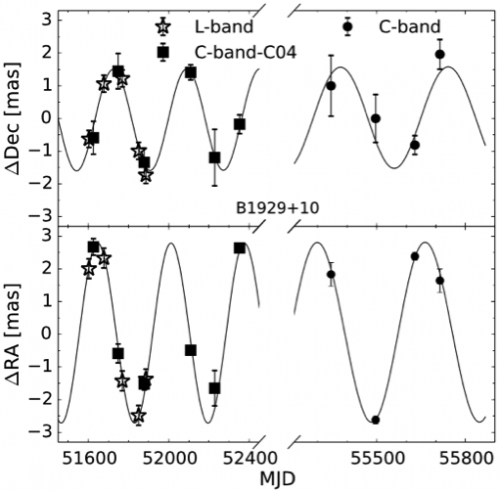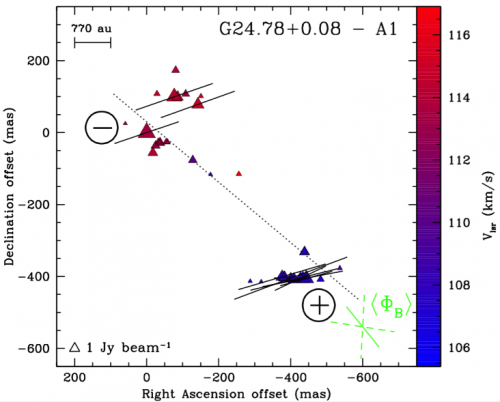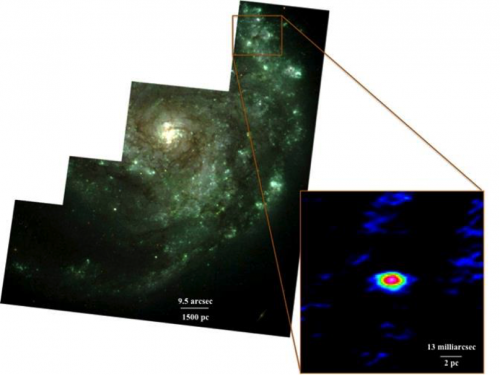Table of Contents
Recent science highlights from the European VLBI Network (EVN)
Introduction
The European VLBI Network (EVN) is a VLBI network of radio telescopes in Europe and beyond, operated by an international Consortium of institutes. The EVN operates an “open sky” policy and observing proposals are accepted (and peer-reviewed) from astronomers from all over the world. The next deadline is June 1, 2016. In order to inspire you, please have a look at the following 3 science highlights from the EVN.
Pulsars astrometry
Extending the time baseline from two years to more than ten years, Kirsten et al. 2015 (A&A, 577, 111, 2015) measured the parallax and the proper motion for the three isolated pulsars B1929+10, B2020+28, and B2021+51 in a global VLBI experiment. Combining their 5 GHz data with that from Brisken et al. 2002 (ApJ, 571, 906, 2002) and Chatterjee et al. 2004 (ApJ, 604, 339) their data on B1929+10 indicates a distance of 360 +/- 7 pc, Fig. 1. In combination with the measured proper and inferred transverse velocity the authors trace the pulsar's trajectory back in time through the Galactic potential. They conclude that the previously made claim that the pulsar once formed a binary system with the runaway O-star z-Ophiuchi is very unlikely. They also conclude that the putative common binary origin of B2020+28 and B2021+51 in the Cygnus Superbubble is very unlikely.
Figure 1. Relative measured positions of B1929+10 with the best fit proper motion removed. The solid line is the best fit parallax from all available data combined. Solid dots show the most recent measurements at 5 GHz, open stars are the data from Brisken et al. 2002 (ApJ, 571, 906, 2002), and squares are the data from Chatterjee et al. 2004 (ApJ, 604, 339).
The magnetic fields around young stellar objects
Since 2009, Surcis and collaborators have been running a large VLBI project with the EVN to measure the magnetic field at AU scales around 31 massive young stellar objects (YSOs). By observing the polarised emission of 6.7 GHz methanol masers the structure of the magnetic field for 19 sources has been obtained so far, an example is shown in Fig. 2. A first statistical analysis of these sources reveals that the magnetic field around the YSOs is preferentially oriented in the same way as the molecular outflows ejected from the sources (Surcis et al. 2015). For several sources it was possible to obtain a detailed description of the magnetic field. The results are published in Surcis et al. 2013, A&A 556, 73 and Surcis et al. 2015, A&A 578, 102.
Figure 2. A view of the methanol masers features detected in the massive star forming region G24.78+0.08. The black segment represents the linear polarisation vectors of the methanol maser feature. The magnetic field is perpendicular to the linear polarisation vector.
The search for intermediate-mass black hole
Based on quasi-simultaneous EVN and Chandra X-ray observations Mezcua et al. 2015 (MNRAS, 448, 1893, 2015) presented the detection of an off-nuclear intermediate-mass black hole (IMBH) of ∼5×104 Msun located in the spiral arm of the galaxy NGC 2276. The spatial coincidence of the EVN source with the location of unresolved, hard X-ray emission is one of the most compelling signatures of an accreting BH, Fig 6. IMBHs may constitute the missing link between stellar-mass and supermassive black holes (SMBHs) and are the potential could be the sources from which SMBHs grow.
Figure 3. Three-color image of the western arm of the galaxy NGC 2276 where the intermediate-mass black hole is located. The image has been created using three filters of the Wide Field Planetary Camera 2 of the Hubble Space Telescope: F814W in red (8 microns), F606W in green (6 microns) and F550W in blue (5.5 microns). The inset shows the EVN radio image at 1.6 GHz, which reveals the presence of a radio structure coincident with the position of the X-ray source.



